Glutamine may repress the weak LPS and enhance the strong heat shock induction of monocyte and lymphocyte HSP72 proteins but may not modulate the HSP72 mRNA in patients with sepsis or trauma
- PMID: 26550577
- PMCID: PMC4621332
- DOI: 10.1155/2015/806042
Glutamine may repress the weak LPS and enhance the strong heat shock induction of monocyte and lymphocyte HSP72 proteins but may not modulate the HSP72 mRNA in patients with sepsis or trauma
Abstract
Objective: We assessed the lipopolysaccharide (LPS) or heat shock (HS) induction of heat shock protein-72 (HSP72) in peripheral blood mononuclear cells (PBMCs) of patients with severe sepsis (SS) or trauma-related systemic inflammatory response syndrome (SIRS), compared to healthy individuals (H); we also investigated any pre- or posttreatment modulating glutamine (Gln) effect.
Methods: SS (11), SIRS (10), and H (19) PBMCs were incubated with 1 μg/mL LPS or 43°HS. Gln 10 mM was either added 1 h before or 1 h after induction or was not added at all. We measured monocyte (m), lymphocyte (l), mRNA HSP72, HSP72 polymorphisms, interleukins (ILs), monocyte chemoattractant protein-1 (MCP-1), and cortisol levels.
Results: Baseline lHSP72 was higher in SS (p < 0.03), and mHSP72 in SIRS (p < 0.02), compared to H. Only HS induced l/mHSP72/mRNA HSP72; LPS induced IL-6, IL-8, IL-10, and MCP-1. Induced mRNA was related to l/mHSP72, and was related negatively to cytokines. Intracellular l/mHSP72/HSP72 mRNA was related to serum ILs, not being influenced by cortisol, illness severity, and HSP72 polymorphisms. Gln did not induce mRNA in any group but modified l/mHSP72 after LPS/HS induction unpredictably.
Conclusions: HSP72 mRNA and l/mHSP72 are higher among critically ill patients, further induced by HS, not by LPS. HSP72 proteins and HSP72 mRNA are related to serum ILs and are negatively related to supernatant cytokines, not being influenced by HSP72 polymorphisms, cortisol, or illness severity. Gln may depress l/mHSP72 after LPS exposure and enhance them after HS induction, but it may not affect early induced HSP72 mRNA.
Figures
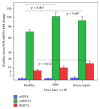
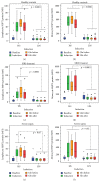
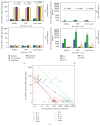
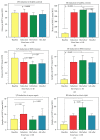

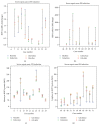

Similar articles
-
Ex Vivo Evaluation of Glutamine Treatment in Sepsis and Trauma in a Human Peripheral Blood Mononuclear Cells Model.Nutrients. 2023 Jan 3;15(1):252. doi: 10.3390/nu15010252. Nutrients. 2023. PMID: 36615909 Free PMC article.
-
Glutamine suppresses Hsp72 not Hsp90α and is not inducing Th1, Th2, or Th17 cytokine responses in human septic PBMCs.Nutrition. 2014 Oct;30(10):1185-94. doi: 10.1016/j.nut.2014.01.018. Epub 2014 Feb 22. Nutrition. 2014. PMID: 24976418
-
[The different effects of glutamine on macrophage cytokines release in vivo and in vitro].Zhongguo Wei Zhong Bing Ji Jiu Yi Xue. 2008 Aug;20(8):456-60. Zhongguo Wei Zhong Bing Ji Jiu Yi Xue. 2008. PMID: 18687170 Chinese.
-
Heat shock protein 72 expressing stress in sepsis: unbridgeable gap between animal and human studies--a hypothetical "comparative" study.Biomed Res Int. 2014;2014:101023. doi: 10.1155/2014/101023. Epub 2014 Jan 12. Biomed Res Int. 2014. PMID: 24524071 Free PMC article. Review.
-
[Cellular and molecular changes of the liver in sepsis and in systemic inflammatory response syndrome (SIRS)].Orv Hetil. 2003 Mar 16;144(11):499-506. Orv Hetil. 2003. PMID: 12731336 Review. Hungarian.
Cited by
-
Ex Vivo Evaluation of Glutamine Treatment in Sepsis and Trauma in a Human Peripheral Blood Mononuclear Cells Model.Nutrients. 2023 Jan 3;15(1):252. doi: 10.3390/nu15010252. Nutrients. 2023. PMID: 36615909 Free PMC article.
-
Suppressed anti-inflammatory heat shock response in high-risk COVID-19 patients: lessons from basic research (inclusive bats), light on conceivable therapies.Clin Sci (Lond). 2020 Aug 14;134(15):1991-2017. doi: 10.1042/CS20200596. Clin Sci (Lond). 2020. PMID: 32749472 Free PMC article. Review.
-
Oxidant/Antioxidant Status Is Impaired in Sepsis and Is Related to Anti-Apoptotic, Inflammatory, and Innate Immunity Alterations.Antioxidants (Basel). 2022 Jan 25;11(2):231. doi: 10.3390/antiox11020231. Antioxidants (Basel). 2022. PMID: 35204114 Free PMC article.
-
Increased extracellular heat shock protein 90α in severe sepsis and SIRS associated with multiple organ failure and related to acute inflammatory-metabolic stress response in children.Medicine (Baltimore). 2016 Aug;95(35):e4651. doi: 10.1097/MD.0000000000004651. Medicine (Baltimore). 2016. PMID: 27583886 Free PMC article.
-
Survivin and caspases serum protein levels and survivin variants mRNA expression in sepsis.Sci Rep. 2021 Jan 13;11(1):1049. doi: 10.1038/s41598-020-78208-2. Sci Rep. 2021. PMID: 33441606 Free PMC article.
References
-
- O'Grady N. P., Barie P. S., Bartlett J. G., et al. Guidelines for evaluation of new fever in critically ill adult patients: 2008 update from the American College of Critical Care Medicine and the Infectious Diseases Society of America. Critical Care Medicine. 2008;36(4):1330–1349. doi: 10.1097/ccm.0b013e318169eda9. - DOI - PubMed
Publication types
MeSH terms
Substances
LinkOut - more resources
Full Text Sources
Other Literature Sources
Medical
Research Materials
Miscellaneous

